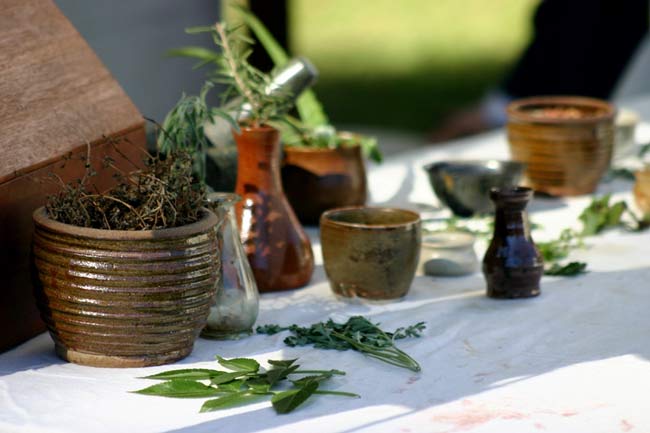Natural Cures Pack Dangerous Chemicals

Ayurveda, a healing tradition from India, is as old as the hills. And apparently ayurvedic medicine available through the Internet contains as many toxic metals as the hills, according to a study published in the Journal of the American Medical Association.
A team from Boston University found that more than 20 percent of nearly 200 samples of various ayurvedic cures contained dangerous amounts of lead, arsenic and mercury. Sometimes the presence of metals was a result of sloppy manufacturing; other times the metals were added deliberately as part of the cure.
The authors — who are advocates of alternative medicine and include an ayurvedic practitioner as well as a lead poisoning expert from India — said they hope their report can help separate wheat from chaff, that is, the useful elements from the ayurvedic tradition from the real whacky stuff.
Problems with ayurveda
India is proud of its ayurvedic tradition, which dates back over 7,000 years and likely predates Traditional Chinese Medicine. By 1000 BCE, when Europeans were still living in mud and beating each other with clubs, Indian doctors used the principles of ayurveda to drain fluids, sew wounds, remove kidney stones and even perform cosmetic surgery.
For the most part, the ayurvedic tradition — which incorporates yoga, meditation and diet — makes for a healthy lifestyle.
But the safety and efficacy of some ayurvedic cures are questionable, because often they incorporate chants and are based on astrology, personality traits, pulse readings, a supposed imbalance of three bodily humors (called vata, pitta and kapha, like China's yin and yang) and other discredited beliefs. Your herbal cure for, say, a bad cough might be different from the next person's as a result of your birthday and Mars being aligned with Jupiter.
Sign up for the Live Science daily newsletter now
Get the world’s most fascinating discoveries delivered straight to your inbox.
Among these odd elements of ayurveda, the JAMA report targets a practice called rasa shastra, which uses mercury and other metals as curatives. Nearly half of the rasa shastra remedies tested had dangers levels of metals; several were 10,000 times over the U.S. safety limit.
Regardless whether you are a Leo or a Capricorn, that's not healthy. So the authors called into question the entire practice of rasa shastra.
India strikes back
Some folks in India didn't take the JAMA report lightly. The Indian Ministry of Health and Family Welfare issued a press release last week that stated:
"It needs to be emphasized that as per the directions issued by Department of AYUSH, herbo-metallic compounds are not being officially exported because of heavy metal concerns and only purely herbal Ayurveda, Unani and Siddha medicines are being exported from India with effect from 1st January 2006 after certification of heavy metals below the permissible limit by the manufacturing unit."
Read between the line, and this implies (a) herbo-metallic compounds still exist in India as part of the ayurvedic tradition; (b) herbo-metallic compounds are being unofficially exported; and (c) and herbo-metallic compounds used to be exported until European and American researchers exposed the practice.
The lead author on JAMA report, Robert Saper, was in fact one of the pesky researchers in 2004 who revealed the fact that more than 20 percent of imported ayurvedic cures in Boston's South Asian grocery stories had illegal levels of toxic metals.
Know your source
Ayurveda has gained popularity in the United States with promoters such as Deepak Chopra, who charges thousands of dollars for seminars about how ayurveda can improve your golf game. The tradition has become somewhat elitist in the United States, with ayurvedic spas, soaps, candles and other luxury items.
Many likely don't know nor want to know about the idiosyncrasies of ayurveda. (We haven't addressed the use of cow urine and dung.) Ayurveda, after all, has much going for it.
But when experimenting with traditional medicines, particularly when you are outside of that culture, it's prudent to understand what you are getting into. The Boston University team is one group of alternative medicine advocates who want to legitimize useful ancient therapies not because they are ancient but because they work.
- Top 10 Bad Things That Are Good For You
- Licensed to Kill: Some Doctors are Real Naturals
- Nutrition Quiz
Christopher Wanjek is the author of the books "Bad Medicine" and "Food At Work." Got a question about Bad Medicine? Email Wanjek. If it's really bad, he just might answer it in a future column. Bad Medicine appears each Tuesday on LiveScience.

Christopher Wanjek is a Live Science contributor and a health and science writer. He is the author of three science books: Spacefarers (2020), Food at Work (2005) and Bad Medicine (2003). His "Food at Work" book and project, concerning workers' health, safety and productivity, was commissioned by the U.N.'s International Labor Organization. For Live Science, Christopher covers public health, nutrition and biology, and he has written extensively for The Washington Post and Sky & Telescope among others, as well as for the NASA Goddard Space Flight Center, where he was a senior writer. Christopher holds a Master of Health degree from Harvard School of Public Health and a degree in journalism from Temple University.









